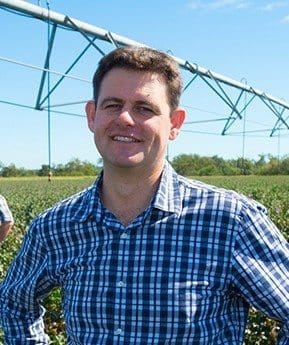AGRICULTURE is entering a brave new world of Artificial Intelligence and Machine Learning where technology is transitioning from basic automation and data collection to a new age of machines and systems with the capacity to virtually think for themselves.
What will this mean for the way we farm? What will a future farm look like? What are the challenges and pitfalls of these advanced technologies? Where will it all lead?
These were some of the issues canvassed by a panel of high-tech farming specialists at an Ag Institute of Australia workshop at the University of Southern Queensland (USQ) in Toowoomba last night.
Panellists who gave their views in a broad ranging discussion included USQ National Centre for Engineering in Agriculture (NCEA) director, Professor Craig Baillie; Vanderfield John Deere machinery precision agriculture manager, Stephen Hegarty; and NCEA adjunct research fellow, Dr Steven Rees.
……………………………..
What is Big Data/Artificial Intelligence/Machine Learning/Deep Learning?
Craig Baillie: Big Data is deriving patterns from large data sources to inform decision making.
Artificial Intelligence takes that data and looks to mimic human intelligence and do something with the data. It is normally related to some sort of automation or decision-making process.
The two concepts overlap. You might be looking for patterns in data that give you an insight into what you should be doing. That may inform Big Data analytics which allows you to predict outcomes.
Within the domain of Artificial Intelligence there are sub-domains. That starts at Machine Learning which is based on statistical measurement, rule-type learning, through to Deep Learning which is trying to mimic the human brain and how it thinks.
Deep Learning is based on artificial neural networks which try to mimic how the human brain processes and makes decisions. The neural networks are trained on data sets to acquire knowledge and apply that knowledge to solve problems. It uses algorithms to self-train from the data.
It allows additional layers to be developed from the primary data that is collected and uses that information to solve other problems.
Deep Learning needs to analyse lots of good quality data to train it. It relies a lot on information.
You may think there is a lot of information in agriculture, but when you apply it to Deep Learning we find we simply don’t have enough data to train a lot of models.
And the data we do have is not very good. We need reliable data. Rubbish data gives rubbish outputs. That is the real issue confronting agriculture at the moment. We need better data infrastructure.
What are the opportunities for these technologies in agriculture?
Craig Baillie: Farming will become more sophisticated where you won’t just plant one variety but will mix it up with different varieties across a field to exploit differences across the field.
The technologies are taking the human element out of play and are improving the precision of farming operations. They provide the opportunity to manage farming operations more precisely.
What will a future farm look like?
Craig Baillie: A future farm will look much like the ones now, but everything will be connected and things will happen seamlessly in the background to automate machinery without human intervention.
There will be machines that know what to do without humans playing with data and manipulating them.
We used to use crop models to simply model a field. In more recent times we use crop models more spatially to model different parts of the field to optimise inputs for the various parts of the field. Where Deep Learning is coming in is it allows you to get down to managing single plants.
The existing technologies like autosteer, automated sprayers, variable rate planters, seed simulation and variable rate irrigation provide a great platform for the application of Artificial Intelligence techniques.
Artificial Intelligence is playing a role in robotics. It is easy to automate a tractor but an autonomous/robotic tractor needs to know what it is doing and the environment it is operating in. It has to be smart enough to know something is going wrong and be able to correct it or stop. That is where Artificial Intelligence comes in.
A vast array of technology is being developed at a rapid rate. Artificial Intelligence is essential, but it is not the ‘silver bullet’.
What happens to these systems if the internet crashes?
Craig Baillie: It depends on the application. If it is dependent on communication it will be a failure but if it is a closed-loop system it will be independent.
Steven Rees: Once the Machine Learning model has been developed for the tractor or machine it is self-supporting. You will still have the system you bought in the first place.
How soon will these technologies be part of everyday farm life?
Steven Rees: The speed of change won’t be as fast as the media will hype it up to be.
It will be like autonomous cars. With the trajectory that development has been on, we should already be seeing autonomous cars on the streets. The fact there are troubles with the introduction of autonomous cars means nobody really knows whether it is still five years, 10 years away.
The rate of change at the autonomous level won’t be as quick as you may think. But at the lower level using Artificial Intelligence to set up harvesters and planters will keep improving and parts of the system will increase with more autonomy.
But a complete autonomous system with, for example, a tractor planting a crop without operator involvement, is still a long, long way away. There is a myriad of sensors that has to be developed before that can take place.
What role are these technologies playing in the machinery industry?
Stephen Hegarty: As an industry, we have been building on the hardware and sensing capability to be able to collect enough data. The next challenge was around making it friendly enough to use.
I think we are now at the tipping point where we are moving beyond the adoption of auto-steering a tractor to where the general market is ready to start adopting some of the other advanced technologies.
Within the last five years we have seen the requirement to move into fleet support as we have moved to greater connectivity.
For instance, all the controllers on a header are connected together. Previously that data was only accessible when you downloaded it onto a USB stick. But now we have connectivity and access to that data, that is a value proposition for the end user.
So, a big part of our business now is operator support, optimising the way the machine is working and increasing the profitability of the machine/hour.
Within the last couple of seasons, because of connectivity, we have seen the grower start to ask for advanced analytics. This is almost becoming a services path within an equipment or hardware business.
What has access to spatial data meant?
Stephen Hegarty: As we have more and more controllers on a machine that are connected together and we can log the time and place of the reading, we can spatialise it and create a map.
The minute you can do that across a production unit on a farm, we can start to use machine telemetry to improve the efficiency of the machine and reduced repairs and maintenance.
We are using machinery telemetry for predicting faults, rather than reacting to faults. We have put the huge data base to good use with John Deere’s ‘Expert Alerts’ where we can predict a fault before it happens.
What will these technologies mean for the future design of farm machinery?
Stephen Hegarty: Re machine size, we will see a mix. I don’t think seeders are going to be much smaller in a broadacre grain system, but a spot-spraying application could easily be carried out by a ‘swarm’ of small units.
Craig Baillie: There will be some machinery that doesn’t need cabs and other machinery used in autonomous mode or in more complex operations where an operator can jump in a cab and drive it.
We are likely to have autonomous systems for less complex tasks and an operator in the cab for more complex tasks that require supervision.
What is the next development?
Stephen Hegarty: We are not far away from putting Machine Learning and Artificial Intelligence to good use with planting.
Instead of just putting prescription rate files for seed and fertiliser into the planter, we will be using multiple previous layers of data, such as crop emergence, biomass, achieved yield and soil sample data, to predetermine the depth and pressure of the planter in different areas of the field to get ideal crop establishment.
…………………………….
This is an edited version of the presentations and panel discussion.
Grain Central: Get our free daily cropping news straight to your inbox – Click here




HAVE YOUR SAY